 |
|

|
 |
TABLE of CONTENTS
 |
100+ MnDOT staff connect with State Fair visitors |
By Mary McFarland Brooks
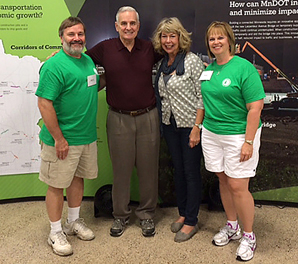
Gov. Mark Dayton stopped by the MnDOT booth at the State Fair Aug. 28. The Governor posed with MnDOT employees Mike Kowski, Metro District maintenance operations; Mary McFarland Brooks, Communications; and Carol Segl, Office of Construction and Innovative Contracting. Photo by Matt Swenson |
Despite a slow start on opening day due to weather, thousands of visitors stopped by the MnDOT State Fair exhibit this year. The fair ran from Aug. 21 - Sept. 1.
The booth theme of “Get Connected” encouraged fairgoers to share their favorite destination and how they traveled to the State Fair in exchange for a chance to win a T-shirt or a Footpaths to Freeways book.
The display featured Corridors of Commerce projects statewide, information about current construction projects and multimodal systems of transportation. The new, larger exhibit space provided a “rest stop” where visitors could take a break and watch videos about innovative technology and the agency’s commitment to Enhancing Financial Effectiveness. Many lingered to ask questions and share their transportation stories.
Gov. Mark Dayton dropped by and gave two thumbs up to the “Orange Cones - No Phones” work zone poster.
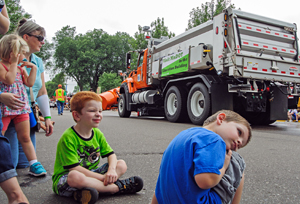
A Metro District maintenance crew drove a MnDOT snowplow in the State Fair parade Aug. 22. Photo by David Gonzalez |
The low turnout on opening day did not prevent the following 11 days attendance of 1,824,830 from making this year’s State Fair the best-attended in history. According to the State Fair website, this is the first time attendance has topped 1.8 million – the previous overall record was 1,790,497 set in 2009.
More than 100 agency volunteers staffed the booth, distributing 22,000 state highway maps, hundreds of fans-on-a-stick, as well as 511 travel information cards.
Staff also handled numerous comments and requests ranging from light rail to construction projects, roundabouts and snowplow safety information.
Just up the block from the Education Building, MnDOT had an added presence in the Eco Experience, a building-size exhibit presented by the Minnesota State Fair and the Minnesota Pollution Control Agency to inspire people to lead more sustainable lives while improving quality of life and the environment.
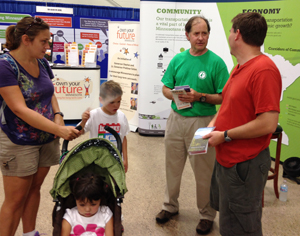
Commissioner Charlie Zelle answered questions from visitors at the MnDOT State Fair booth Aug. 31. Photo by Kevin Gutknecht |
The Kick Gas booth, staffed by MnDOT Transit employees, is a partnership exhibit between the agency, Metro Transit, HOURCAR, Bike Walk Twin Cities, Nice Ride, Bicycle Alliance of Minnesota and local bike shops and organizations. The state bike maps were a hot ticket at both the MnDOT booth and the Kick Gas booth.
MnDOT snowplows and crews from the Metro District were a big part of the State Fair daily parade for three of 12 days of the fair. Banners attached to the plows encouraged fairgoers to visit the booth and many did just that.
|
 |
|

|
 |
TABLE of CONTENTS
 |
Project update: I-35W project to relieve congestion in Minneapolis |

The Interstate 35W project in Minneapolis will add a new ramp from 4th Street South to northbound I-35W to help ease congestion. Photo by Rich Kemp |
Access to northbound Interstate 35W out of Minneapolis will become easier this fall because of a collaborative effort between Hennepin County, the city of Minneapolis and MnDOT.
The project will relieve congestion, improve transit access, reduce the traffic that diverts through northeast Minneapolis, and improve safety and access at the northbound I-35W ramps.
“Work is progressing,” said Garrett Schreiner, project engineer. “When it’s completed in November, this project will help reduce congestion in the downtown and northeast Minneapolis area.”
Crews are adding a new ramp from 4th Street South to northbound I-35W, constructing an auxiliary lane from University Avenue to the Johnson Street exit, reconfiguring the Johnson Street exit and building a noise wall on the west side of I-35W between Broadway Street and Johnson Street.
Begun this spring, the project is using the design-build process so the contractor can design and work on the project concurrently, allowing for more flexibility. The $15.4 million project is on schedule to be completed in November.
More information can be found on the I-35W/Fourth Street ramp project website. |
 |
|

|
 |
TABLE of CONTENTS
 |
Truck-mounted paver saves state $1.4 million |
|
By Sue Roe
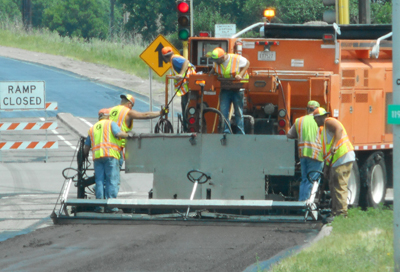
A crew applies microsurfacing to a frontage road on North Lyndale in Minneapolis. The “micro” crew includes Brian Gorr, Mathew Miller, Nicholas Palumbo, Jeff Jones, Alex Bruch, Dustin Lymer and Thomas Loberg. Crew members not shown include Thomas Loberg, Curt Lund, Donald Carlson and supervisor David Lemma. Photo by Jan Theisen |
A machine that paves small segments of roadway to extend the life of the highway is proving to be a good investment.
“We’ve seen the results from it and it’s been nothing but positive,” said Cliff Gergen, Metro District’s transportation operations superintendent. “It’s already paid for itself and it puts another five to seven years of life back into the roadway and increases the ride quality.”
The truck-mounted paver lays a thin layer of protective seal coating on the existing pavement. The technique, called microsurfacing, has several benefits, one of which is $1.4 million savings in its first year of use.
Microsurfacing is a cost-effective method to renew the road surface, seal minor cracks and other irregularities, such as pavement wheel ruts. The paver does smaller jobs such as short road segments and ramps.
“MnDOT does work that is immediately needed and not conducive to contracting out because of the length of the road, the work type or contracting timelines,” said Gergen.
Average cost of microsurfacing with the new paver is about $30,000 per lane mile, which includes overhead costs of labor, equipment and materials. Contract microsurfacing costs $50,000 per lane mile. A new pavement can cost $1.5 million per mile.
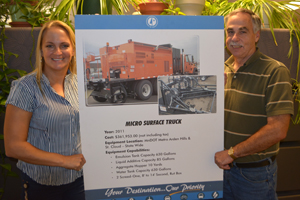
Mindy Heinkel, smooth pavement coordinator, and Cliff Gergen, Metro transportation operations supervisor, display features of the microsurfacing truck that saved MnDOT $1.4 million in its first year. Microsurfacing extends the life of a road, increases ride quality and reduces traffic delays because the technique allows roads to be open within an hour. Photo by Sue Roe |
Gergen said the paver microsurfaced about 70 miles since 2012, when it began service. That’s a cost savings of about $1.4 million in just the Twin Cities area.
Besides the cost savings, microsurfacing results in only minimal traffic delays. Most roads reopen within an hour after the new surface is put down. Normal removal of the top layer of pavement, called milling, and then placing a new layer, called overlay, can take days for the new surface to cure and the road to reopen.
The paver is a self-contained unit and the materials used in the microsurfacing process are stored separately to avoid contamination. Operators use an on-screen manual inside the truck to adjust the ratio of materials according to such factors as temperature and humidity.
“The whole process is more eco-friendly than mill and overlay,” said Gergen.
He also said the paver keeps crews from patching cracks in the road by hand.
“The materials we use increases friction of the roads around curves, so there’s a safety benefit, too,” said Gergen. |
 |
|

|
 |
TABLE of CONTENTS
 |
“Conversation with Deputies” updates employees on current topics |
Battles, agency efficiencies and legislative timelines headlined the “Conversation with the Deputies” discussion Sept. 2 that packed the Central Office cafeteria and had an additional 260 employees tuning in from remote locations statewide.

Sue Mulvihill, deputy commissioner/chief engineer; Eric Davis, chief of staff; and Erik Rudeen, Government Affairs; spoke during “Conversation with the Deputies” Sept. 2 in the Central Office cafeteria. Photos by Rich Kemp |
Deputy Commissioner/Chief Engineer Sue Mulvihill kicked off the nearly hour-long discussion with a re-cap of MnDOT’s Wildly Important Goal of Enhancing Financial Effectiveness, which includes the four “battle” areas—Program Delivery, Asset Management, Financial Management, and Information and Outreach. She noted that EFE also includes WIG-supporting activities that don’t fall under the Battles but contribute to the agency being more financially effective. Mulvihill cited examples such as District 1’s effort to reduce beaver management costs, as well as District 3’s pavement patching work, as ways that individual work areas are contributing to the EFE effort.
Eric Davis, chief of staff, talked about MnDOT’s legislative requirement to find savings in FY 2015 that are the equivalent of 5 percent of the state’s $850 million road construction budget. He said the agency rounded the targeted savings goal up to $50 million, and already has found savings of about $40 million due to bids coming in significantly under the project estimate.
Davis said that MnDOT is looking at a number of additional ways to improve its processes and reduce costs, including in the areas of procurement, contracting, maintenance and operations, and shared services.
Erik Rudeen, Government Affairs, walked through the timeline for submitting proposals for inclusion in the 2015 legislative session, which begins Jan. 6. Upcoming deadlines include MnDOT offices providing draft language to Government Affairs by Sept. 12, getting final approval from Division Directors by Sept. 23, and sending MnDOT’s preliminary proposals to the Governor’s Office/Minnesota Management & Budget by Oct. 1.
A summary of the 2014 legislative session, including MnDOT’s “Unsession” legislation, is on the Government Affairs web page.
See Sept. 2 Senior Leader Conversation, for a video of the discussion that includes a Q & A session with employees. |
 |
|

|
 |
TABLE of CONTENTS
 |
MnDOT hosts livable, transit-oriented conference Sept. 22-24 |
|
By Shannon Fiecke, Research Services & Library

MnDOT will host Rail-Volution, the nation’s premiere conference on livable and transit-orientated communities Sept. 22-24. |
More than 1,000 transportation and urban planners will descend on one of America’s most bicycle-friendly cities Sept. 22-24 for Rail-Volution, the nation’s premiere conference on livable and transit-oriented communities.
This is the first time in Rail-Volution’s 20-year history that the annual event will be held in Minneapolis — and the timing coincides perfectly with the recent opening of the Green Line connecting Minneapolis and St. Paul.
“This is an opportunity to showcase what we’re doing and where we’re going — not just with transit, but also with transit-oriented development,” said Mark Nelson, program manager for statewide planning and transportation data analysis.
More than a year of planning has gone into bringing Rail-Volution to the Twin Cities. Check out the Rail-Volution video.
Participants have a choice of 80 wide-ranging workshops over four days focused on transit and livability, such as innovative parking, planning for small and mid-sized cities and emerging issues for CEOs and public officials.
MnDOT was selected to hold the annual four-day event in a joint application with the Counties Transit Improvement Board and the Metropolitan Council. Not only is this a rare chance for urban planning enthusiasts to attend an internationally renowned conference in their own backyard, but it’s also a great “show-and-tell” opportunity.
As a host, MnDOT will help lead 24 mobile workshops around the Twin Cities, highlighting what Minnesota has done (or is planning), such as engineering light rail in a complex urban corridor, bike-oriented development on the Midtown Greenway and redevelopment along the St. Paul riverfront (by way of a paddle-guided tour).
Not only was the Twin Cities region at a great crossroads in time for hosting such a conference, with its ongoing urban redevelopment efforts and metropolitan area transit plans, but the state’s commitment to these efforts also showed.
“We think part of the reason we were successful is that a state DOT was a co-sponsor. That’s fairly unique. It’s usually a regional government,” Nelson said.
RailVolution, whose offices were previously headquartered in Portland, Oregon, relocated in January 2013 to Minneapolis. |
 |
|

|
 |
TABLE of CONTENTS
 |
Donated vacation hours sought for Tamie Roudebush |

Tamie Roudebush, accounting officer in the Metro District, has been approved for the state vacation donation program. Photo courtesy of the Metro District |
Tamie Roudebush, accounting officer in the Metro District, is now eligible for the state vacation donation program, which allows employees to donate up to 40 hours of vacation per fiscal year for approved recipients who have exhausted their sick and vacation leave due to injury or illness.
In November 2011, Roudebush was in a serious automobile accident. As a result of the accident she has life-threatening injuries and an upcoming spinal surgery.
Due to her medical condition, numerous doctor appointments and pain management, Roudebush has exhausted all of her sick and vacation leave.
To donate vacation leave:
- Go to Employee Self Service Website, click on “Other Payroll,” then “Leave Donations.”
- Select the magnifying glass next to “Reserve Bank” and choose “Roudebush”
- Enter the number of hours you wish to donate
- Click on the yellow “Save” box
Donation forms are also available from your Payroll or Human Resources office or at www.mmb.state.mn.us/doc/vacation/pe665.pdf.
|
 |
|

|
 |
TABLE of CONTENTS
 |
FIRST driver Jonathan Sabie keeps traffic flowing, motorists safe |
By Sue Roe
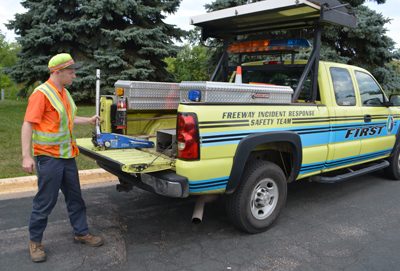
Jonathan Sabie is a 10-year veteran of the Freeway Incident Response Safety Team, or FIRST. The bright yellow pickups contain defibrillators, first aid bags, gas cans with gas, coolant and water, floor jack, traffic cones and materials to clean up spills. Sabie and the other 17 FIRST truck drivers provide timely response to incidents impacting traffic. Photo by Sue Roe |
Jonathan Sabie has one of those jobs where he never, ever knows what’s going to happen each day. Sabie is one of 18 FIRST, or Freeway Incident Response Safety Team, drivers who travel the Twin Cities freeway system, responding to incidents impacting traffic.
“You never know what you’re getting into and you don’t know what to expect,” Sabie said. “Whatever needs to be done, we do.”
Sabie, a 10-year veteran of the job, patrols a 30-mile route in north Minneapolis covering interstates 94, 694 and 35W. He averages 20 to 30 calls daily.
Most incidents are detected by FIRST drivers patrolling their routes. The other calls are dispatched from the Regional Transportation Management Center, 911 or State Patrol. FIRST operates 18 hours a day on weekdays and limited hours on weekends.
Sabie came to MnDOT as a student worker in the SEEDs program. He did a ride-along in a FIRST truck and liked it, so when an opening came up, he applied. At the time, he was a dispatcher in the RTMC. Sabie has a degree in civil engineering from the University of Minnesota and certification from Dunwoody College of Technology in the automotive technician program. Like all FIRST drivers, he also has an EMS First Responder certification.
What’s the purpose of the FIRST program?
The main reason is to improve traffic flow. We want to get crashes, stalled cars and debris off the highway as fast as possible to prevent congestion, gawkers, slow-downs and secondary crashes. We also do whatever we can to help get motorists get going again and to be safe. That ranges from locating, assisting and removing stalled vehicles, crashes and debris, to providing gas, changing tires, doing minor vehicle repairs, pushing disabled vehicles out of traffic and impounding abandoned vehicles. I also assist the State Patrol with first aid and traffic control at crash scenes.
What was your day like yesterday on the job?
I worked a 10-hour shift, drove about 160 miles and responded to 20 incidents. My day started around 11:30 a.m. with a pickup towing a trailer that lost a wheel, blocking a lane of I-35W in south Minneapolis. There was no way to move the trailer or fix the damage, so I provided traffic control until a tow truck arrived.
After the trailer cleared, a mile down the road I came across a car partially blocking the 36th street exit ramp. The front wheel came off the car causing damage so I waited for another tow truck.
At 1 p.m., I reversed the direction of traffic in the I-394 reversible HOV lanes by closing the eastbound gates, driving through the HOV to inspect the gates, checking for stalls or debris and then opening the westbound gates. At about 2 p.m., I was dispatched to an incident blocking the exit ramp from east Hwy 36 to Lexington. A Roseville fire truck was with a car that hit road debris, puncturing the vehicle’s gas tank.
Next, I provided traffic lights for a stalled car and tow truck on I-35W at I-694. One minute after clearing that incident, I came upon a vehicle blocking an exit ramp whose front wheel locked up. I got the car to the shoulder where the driver waited for a tow truck.
At around 2:30 p.m., I was dispatched to a crash blocking the exit ramp on Hwy 100 at 57th Avenue. It was fairly minor, so I moved the crash to a safer place to improve the flow of traffic and for our own safety, and waited for the State Patrol.
After that I was dispatched to remove some debris in the lanes and check two stalled cars that hit the debris on I-94 in north Minneapolis. However, before I got there, I was re-dispatched to a four-car crash blocking most of the highway on I-94 near I-394. I was the first responder to arrive and it was a fairly chaotic scene. Two cars were totally destroyed in the center of the highway and there were car parts everywhere. I put flares down to keep people from driving through the crash scene, checked with the involved parties to find no one was seriously injured and then swept up the mess. As other responders arrived, we pushed the vehicles to the side of the road and waited for tow trucks.
After that crash cleared I was dispatched to remove a tire from the center lane on I-35W near Stinson Avenue. For the next two hours, I checked on some stalled cars, changed a flat tire and jump-started a stalled vehicle in the right lane of I-35W near downtown Minneapolis.
At around 7:45 p.m., I responded to a hit-and-run crash blocking the left lane of the Lowry Hill Tunnel. After cleaning up the debris, the car was able to “limp” out of the tunnel to the shoulder where we waited for a tow truck.
Next, I was dispatched to impound an unoccupied car that had been sitting on the highway all afternoon. On my way to tow the car I came across a different car with a flat tire. After I changed the tire, it was 8 p.m. and I headed back to our shop in Richfield. On the way back I came across another stalled car with a flat tire. I had them move to a safer spot and determined that they already had the spare tire on the car. Since there was nothing else I could do to help them, they called for a tow. I made it back to our shop at 8:30 p.m., refueled and resupplied my truck and went home.
What is the greatest challenge of your job?
I’m regularly being thrown into unknown and dangerous situations and then having to make immediate decisions on how to best resolve them. I’m often first on the scene. I’ve gotten use to stopping for stalls or crashes on the highway, often in the lanes of traffic or in dangerous spots; it’s just part of the job. However, somewhat regularly I get “thrown a curve ball” where I come across a drunk driver, a medical situation, uncooperative or violent individuals or you name it; anything you can think of happening can and does happen on the highways and sooner or later I come across it. I just need to keep calm, think fast and do the best I can with whatever situation comes my way.
What are a couple of the most memorable moments you’ve had on the job?
I’ve had many memorable events through my 10 years as a FIRST driver. Many of them are bloody or tragic and some are funny or goofy, but hard to describe in just a sentence or two, but here are a couple of quick ones. One incident was when I “saved” an unresponsive diabetic person who crashed their car by giving them the sugary fruit rollup from my lunch box. Another incident was when I was the first person on scene with a person about to jump off a bridge over 35W. We talked for five minutes or so until the police arrived and eventually she got off the bridge ledge.
What is the most rewarding thing about your job?
I get to help people all day long. Whether it’s the diabetic person who needs sugar, the girl about to jump off the bridge or someone whose car broke down in the middle of the highway and just needs a little help, it really feels good to help people and, on top of it all, I get paid to do it!
Do you or a co-worker have an interesting job to share with readers? Click here to send us your ideas, and we’ll contact you for more information.
Recent employee profiles:
|
 |
|

|
 |
TABLE of CONTENTS
 |
Agency bicyclists take National Bike Challenge |
By Sue Roe
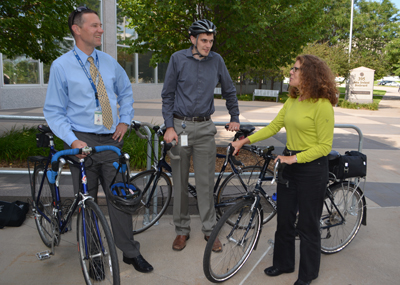
Eric Davis, Peter Dahlberg and Liz Walton are three of the 10 MnDOT employees taking the National Bike Challenge. The 10 employees logged 11,793 miles since May 1 and the team is currently ranked 267 in the nation. Photo by Sue Roe |
Ten MnDOT employees are part of the 2014 National Bike Challenge to raise awareness of the health, economic and environmental benefits of bicycling. Currently, more than 45,000 riders are participating nationwide, including 1,652 Minnesotans.
MnDOT employees in the challenge include Liz Walton, Mike Schadauer, Eric Davis, Philip Schaffner, Kevin Gutknecht, Peter Dahlberg, Tony Wotzka, Ed Krum, Michelle Pooler and Melissa Barnes.
As of Sept. 2, the 10 employees rode 11,793 miles since May 1. The nationwide challenge runs through Sept. 30. The MnDOT team is currently ranked 267th nationally.
Participants log in their miles weekly and the National Bike Challenge website calculates the impact their riding has had on the environment and economy. The team burned 639,257 calories, saved $6,663 from not using gas-powered vehicles, and saved 10,614 pounds of carbon dioxide since May 1.
Schadauer, Transit director, leads the MnDOT team and is currently ranked first in the state and 56th nationally. He rode 5,478 miles since May 1.
Liz Walton, landscape architect in the Office of Environmental Stewardship, bikes 24 miles round trip each day to work.
“We all bike for different reasons and it’s nice to set an example,” said Walton. “Once it becomes a habit, it’s pretty easy.”
Dahlberg, Freight and Commercial Vehicles Operations, rides about 20 miles to and from work a few days a week.
“It’s a fun way to keep track of your biking and it keeps you thinking about using the mode as much as possible,” said Dahlberg.
Wotzka, landscape design specialist in the Office of Environmental Stewardship, bikes mostly for fun and said it’s a great way to see the state.
“I love exploring our cities, roads and trails on bike. It’s a unique perspective that you can only get on two wheels. The added exercise and positive environmental impact is a bonus,” said Wotzka.
Davis, chief of staff, rides from Stillwater to work a few times each week using the Gateway Trail most of the way. Sometimes he rides half way and then takes the bus or rides one way and takes the bus the other way.
“The challenge makes it fun to compare yourself with how others are doing,” said Davis.
Interested persons can still sign up for the challenge by going to the website at https://nationalbikechallenge.org. |
 |
|
______________________________________________________________________________ -->
| |
|



